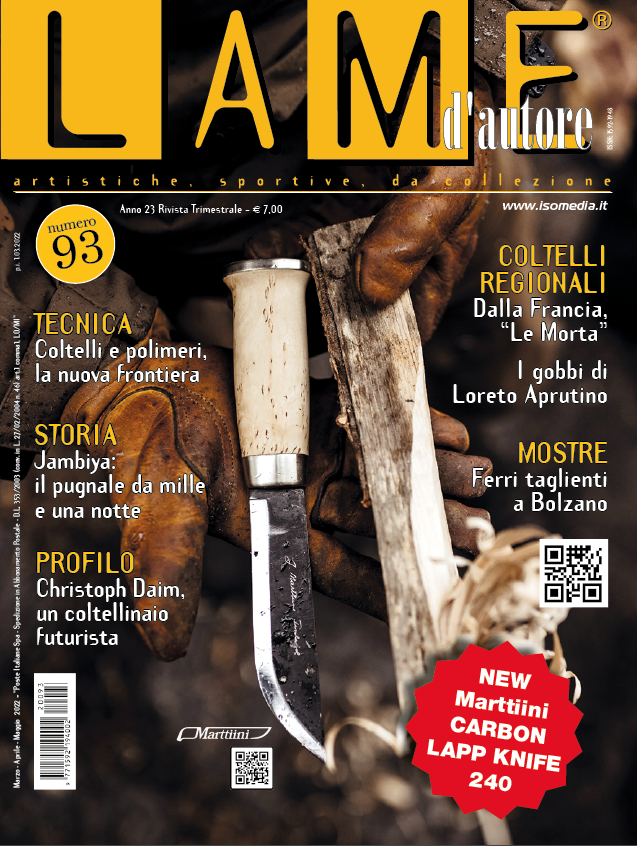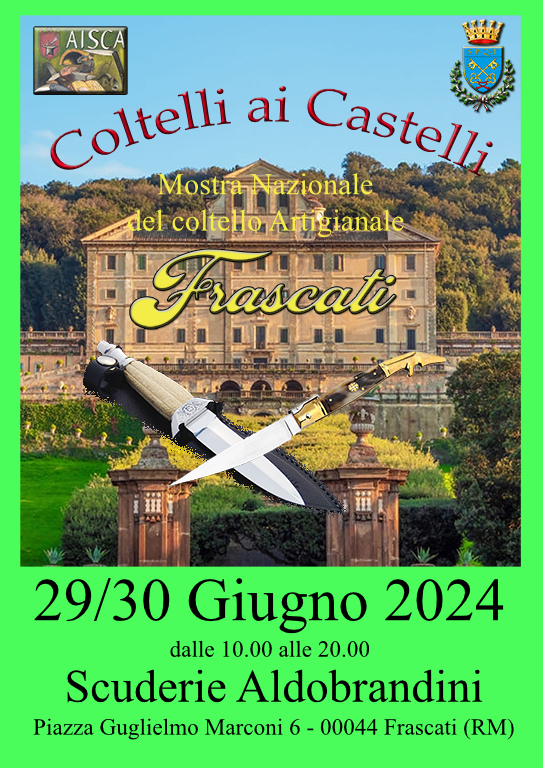L’articolo, in italiano, completo di testo e belle immagini è pubblicato sul n. 93 di LAME D’AUTORE
ENGLISH VERSION OF THE ARTICLE PUBLISHED ON THE PAGES OF LAME D’AUTORE NO. 93
COMPANIES
The knives from the Great North
Angelo Panitti
There is a special Land up north.
A Land where the alternation of day and night does not follow our usual rhythms.
A Land with a two months long night.
A Land with unique colors, where the nights light up with green, red, yellow or blue.
The Land of the Revontulet: the land of the fire fox.
An ancient myth, according to which a magical fox, running, hitting the blanket of snow with its tail causing sparks and these, flying in the sky, gave life to the Northern Lights.
It is the Lapland.
For over fifteen centuries people have inhabited these apparently inhospitable lands, farming reindeer, hunting and fishing.
These three activities have allowed them to live in this unique and selective Land.
Clothing, tools and any other object for daily use have been obtained from the Northern nature.
All activities where the use of a blade is a necessary daily routine.
A need that led to the birth of the typical Nordic knives, the puukko.
Always hanging from the belt of the people living in the Arctic regions, the puukko can have different shapes and sizes depending on the use.
There is the large knife, used instead of the ax, the everyday knife, used for all kinds of needs, the fish fillet knife and the marking knife, which is used to engrave the marks on the reindeer cubs ears.
The handle ismade in birch, sometimes with reindeer antler inserts, or totally in reindeer antler, while the scabbard has generally a string and it is used to hang the sheath by the belt.
The traditional engravings on the blades can show geometric motifs of stars, flowers or lines full intertwined.
Still today the gift of a knife to a person is still a gesture full of symbolic meanings.
The knife is also used to carving the Kuksa, the traditional wooden cup that can be carried tied to the belt. It is made by hand by cutting and working the birch root, much more resistant than simple birch wood and, when well done and well cared for, it is a lifetime object. It can have different sizes depending on its use and different processes, so the handle could have one or two holes or it could have inlays, made with reindeer antlers. It was and it is still used, to pick berries and to drink hot or cold drinks and, after the use, it is rinsed with water and left to dry.
Just like puukko knife, kuksa is an essential object that people always carry with them in the wilderness.
It is most valued when it is made by oneself or received as a gift.
With these premises it is easy to understand that the knife is something that goes beyond the mere tool and the shape and geometry of the blade are dictated by the uses to which it will be subjected; the materials will be those present in the area and susceptible to the available processes.
Thus are born the puukko knives.
And so a name was born, a name that made the history of the Nordic knife: Marttiini.
It all began in 1928, when a blacksmith named Janne Marttiini decides to found a knife factory in Rovaniemi, in Finnish Lapland.
With his own experience and with the user in mind, he begins to create beautiful but superior quality utility items, to be used in the most difficult, imaginable conditions.
And it would be easy to be fooled by the beauty of the lines, but it is precisely when you put one to the test that you realize how it is perfect for your needs.
Marttiini currently uses different materials to realize the knives. The handles can be in two different essences of birch, various qualities of wood or in synthetic materials, such as rubber or G10.
The metal used for the blades can be stainless steel, traditional carbon steel, Damascus steel, and steel with a special dirt and moisture repelling Martef coating, that reduces friction and makes cleaning the blade easily.
The sheaths are mainly made of high-quality leather. Also extremely durable nylon and hygienic plastic sheaths are offered for knives that are used in damp conditions.
The correct combination of the above elements allows to diversify the production and to adapt the finished product to the different needs.
In this way, you have the possibility to choose to favour the corrosion resistance or the tightness of the wire or the ease of sharpening, depending on whether the knife will be used to clean the fish or to cut wood.
In the name of this variety we will see below three different knives:
the Carbon Lapp 240, the Wild Boar and the Lynx Black.
Carbon Lapp Knife 240
The blade is made of carbon steel, 13 cm long and obviously the sharpness is 22 degrees of the Scandi type.
The blade is tempered dark, while the bevels are polished.
The declared hardness is 59.5 degrees HRC.
The handle is made in curly birch that visually contrasts with the color of the blade and it is treated with wax to waterproof it and it has a steel bolster and rear knob.
The sheath is in natural-colored leather, with the company name embossed and it almost completely wraps the knife, sealing it from the elements.
I find it an extraordinarily beautiful and functional knife, with a carbon steel blade that is still easy to sharpen; it is the perfect choice for everyone is looking for a versatile companion and, with due maintenance, extremely long-lasting.
Wild Boar
Nomen Omen: the knife is very similar to the animal that is the source of inspiration, strong, noble and hard!
The blade is in stainless steel, 11 cm long, has a clip point profile and scandi sharpening.
It is completely polished and has two subtle blood grooves.
Hardness is around 54-55 degrees HRC.
The handle is in curly dark-colored and waxed birch.
The upper bolster and zoomorphic head are made by bronze.
The scabbard is in black leather, has a bronze band that acts as a link for the suspension string and also features the effigy of a golden boar’s head.
A wooden presentation / gift box completes the equipment.
Linx Black
The traditional Lynx model dressed in a dress, modern and elegant black color.
The blade is made by forged carbon steel and it is perfect for carving; it has a length of 11 cm straight back type with dark forge profiles and polished bevels.
The declared hardness is 59.5 degrees HRC.
The black birch handle has a protective oil coating and features a brass head and an index finger groove for a better grip, together with the final profile of the handle itself.
The sheath is in black leather, with decorative engraving and embossed with the house logo.
The Lynx knife, with a slightly upturned blade tip, is an iconic Marttiini model developed in the 30’s by Janne Marttiini himself. It is still one of Marttiini’s most popular knife models.
The three models proposed by the Marttiini factory, nowadays situated in the village of Vääksy – Finland, are practically a small taste of Marttiini’s current production and by looking carefully in their catalog, you can certainly choose the model that best suits your needs, or choose models in limited or customized series. There is a special Custom Shop tool online at www.marttiini.fi where you can design your own knife. Their knifemaking professionals will individually handcraft your dream knife in the Vääksy factory and they will ship it to you worldwide (as all the knives are individually made on demand, this takes 4-6 weeks).
The three big cornerstones of the Marttiini knife manufacturing are: the fine craftsmanship, functionality and high quality.
And the prices are the most honest prices you can find in today’s production!
For almost a century, the Marttiiini knives have been firmly in the belt of thousands of hunters, fishermen or anyone who lives and works in the outdoors.
As soon as you handle one it is impossible not to appreciate its qualities: secure the knife in the belt and it disappears; you use it and you are amazed about the ergonomics of the handle after hours of work and it is useless to speak about the cutting capacity of the blade.
All knives arrive at the customer with a razor sharpening and the company directly reports, for each model, the correct sharpening methods to restore the blade after heavy use.
The wooden handles then offer the possibility of intervention by the owner, who can adapt the handle to his hand with a minimum of manual skill and, if it is not enough, you can choice to ask for a customized knife.
The Marttiini knives are aimed at a target as vast as they are demanding: practical people, who know exactly what tool they want, they know how to use it and they are not distracted by modern acronyms and high-tech finishes.
Marttiini are modern blades but with a strong nostalgic soul.
They invite you to go back to the past, to spend moments around a fire, sipping a hot drink in your cup, carving something for a loved one.
Moments that transcend the heat of the flame.
Moment of human warmth.
I advise everyone to own one of these knives, to use it, to seek and to enjoy those moments, because they so rare today.
A personal thanks to Team Marttiini all, for the kindness and friendship shown to me.






